





While we are all familiar with iris, you may not be aware that there are several iris look-alikes native to more tropical environments. These iris wannabes include the Walking Iris (Neomarica) and the Cape Iris (Dietes)These may be grown as outdoor plants in zone 9 and warmer or as houseplants which may be kept outdoors in the summer. If you would like to learn more about these tropical iris relatives, continue on.
I imagine that all gardeners are familiar with iris. Certainly, for gardeners in temperate zones, they are one of the premier garden plants. But what about gardeners living in the subtropics and tropical areas? Most iris are not suitable for growing in such climates. However, there are several iris look-alikes that are ideally suited to the tropics. These include the walking iris, (Neomarica species) and African or Cape iris (Dietes species). Not to fret, even us northern gardeners can enjoy these tropical ‘iris' as easy-to-grow houseplants. Both genera differ from the real iris by having their 6 tepals (3 petals and 3 sepals) completely separated (on true iris they are fused at their base). Neomarica can be separated from Dietes by their distinctly curled petals.
The walking iris or Neomarica, is composed of about 15 species, most native to South America, especially Brazil. Plants produce a dense clump of sword-like leaves which may reach 60 to over 150 cm in length. The flowers are often produced singularly over a number of days. Each bloom only lasts a few hour! If grown outdoors, they will tolerate full sun to part shade but as a houseplant, full sun will increase your chances of getting reliable blooms. This genus is not particularly frost hardy and is rated for zone 9-10. Indoors, they can tolerate winter temperatures as low as 15 C or 60 F. Keep them on the dry side during the winter months but water freely in the summer. They may be propagated by simple division or in the case of N. northiana and N. gracilis, by plantlets that develop at the ends of the flower stalks.
There are five main species common in cultivation. Neomarica brachypus and N. longifolia are nearly indistinguishable as both have yellow flowers with a brown band. They have leaves 50 to 60 cm with flower stems that exceed the length of the leaves. Neomarica northiana and N. gracilis are also very similar look-alikes. Both have relatively large white flowers with intricate blue and brown markings. They are both delightfully fragrant. After the flowers pass, new plantlets form at the end of the flower stems. These eventually bend to the ground and root as a new plant, hence the ideal of a ‘walking' iris. The last popular species is N. caerulea, the giant of the genus, whose leaves may reach 160 cm. It produces pale blue to lilac, fragrant flowers with intricate yellow and brown markings.
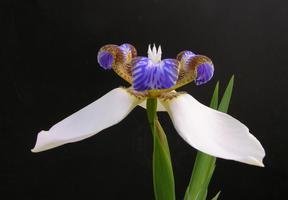
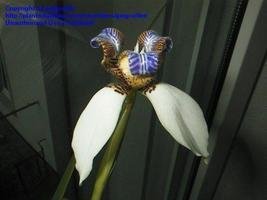
Details of Neomarica gracilis (left) and N. northiana (right)
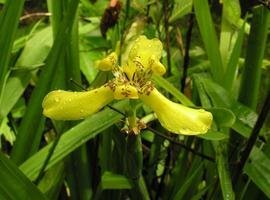
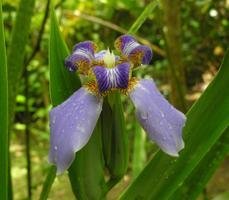
Details of Neomarica longifolia (left) and N. caerulea (right)
The African or Cape iris (Dietes species), as the name suggests, are native to Africa and consists of only 6 species. Plants also produce a dense clump of leaves, but Dietes have quite narrow, more grass-like foliage. Their flowers are rather similar to those of Neomarica and will last 1-3 days each. They are generally more floriferous than Neomarica and bloom sequentially over several weeks. This iris wannabe is slightly hardier than Neomarica, several being rated to zone 8. Again, full sun, both outdoors and indoors, will result in the most flowers. They can tolerate rather poor dry soils. Propagation is by division or seed. In fact, this genus can multiple quite quickly by seed, so much so, it can become a pest. Prompt dead-heading will help curb their capriciousness to self-seed.
There are four species commonly seen. Dietes bicolor will reach 60-100 cm and has cream-white flowers whose three outer petals (technically the sepals) have a blackish blotch and bright orange markings at their base. Dietes grandiflora will reach a similar size and has white to ice-blue flowers whose sepals have a large yellow base. Dietes iridiodes appears essentially like a smaller version of D. grandiflora, reaching 30-60 cm. Growing at an elevation of 2000 m, this native of the Drakensberg Mountains is considered the hardiest species. It is worthy of trying in zone 7b if provided with a thick mulch layer. The last species of note is D. robinsoniana. This is the giant of the genus, reaching upwards to 2 m. It is also the most tender species. Its flowers are quite large, being white with a distinct orange-yellow blotch at the base of the sepals. They have a sweet, honey-like fragrance.
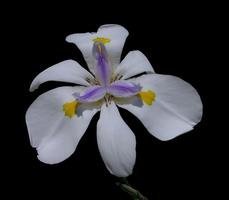
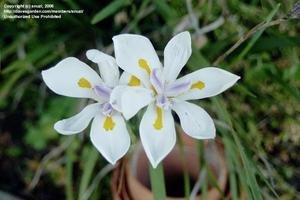
Details of Dietes iridioides (left) and D. grandiflora (right)
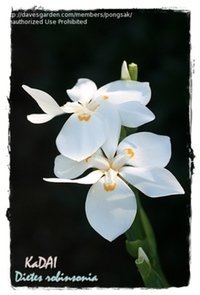
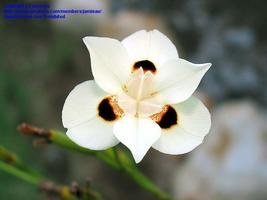
Details of Dietes robinsoniana (left) and D. bicolor (right)
So if you live in a rather tropical climate or would like to grow an iris-like plant indoors, the Neomarica and Dietes are the plant for you!
I would like to thank the following people for the use of their pictures: gregcutler (N. northiana), jamieau (D. bicolor), pongsak (D. robinsoniana) and snuzi (D. grandiflora).
Copyright © www.100flowers.win Botanic Garden All Rights Reserved